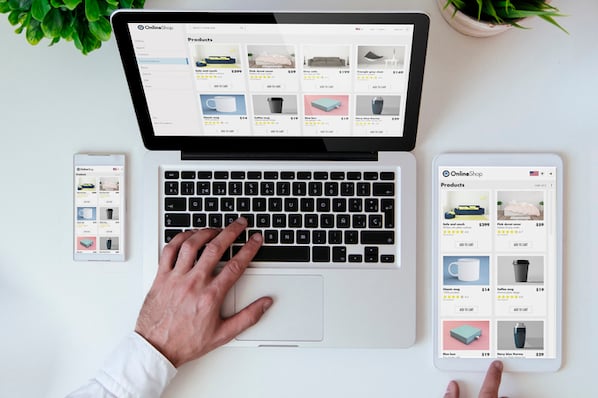What Exactly is Visual Search?
Visual search is an artificial intelligence technology that allows users to conduct an internet search using a picture, rather than keywords.
This is different than conducting an “Image Search”, in which the user types a text-based query into Google, clicks on the “Images” tab, and scrolls through pictures which the search engine has compiled as the best visual matches.
Instead, a visual search actually starts with a picture and uses deep neural networks to decipher what is in it, taking into account shape, color, and size. The user is then served with the exact object or place being searched, or whatever is most similar to it.
Unsurprisingly, visual search works best in visual mediums. If you're searching for the right college to go to, which tax guy to use, or what type of editing software to buy, visual search is unlikely to help. However, if you are looking for the right style of home décor, a dress for a special event, or data on a location you've found yourself in, visual search is the most efficient tool you can use.
Remember that 90 percent of the information received by our brain is visual. Sometimes words fail us when we're trying to accurately describe something we see. That is why visual search is so powerful, and why the world's biggest enterprises are investing in it.
Who is Using Visual Search?
A quick (text-based!) Google search will show you that quite a few high-profile companies are using visual search and talking about it a lot. The most major one is Google itself.
Over the last couple of years, Google has rolled out visual search capabilities which it calls "Google Lens," which can perform an array of mind-blowing actions that integrate technology even more seamlessly into your everyday life.
For example, say you're exploring a new city and come across a restaurant you might want to try. You can't clearly see the name or address of this place from across the street, so you simply scan a picture of it into Google Lens. Within seconds, you are served its name, address, menu, Yelp ratings, reviews, and even alerts if friends of yours have eaten here before.

Besides Google, there's also Pinterest, whose visual search is on the verge of transforming online advertising as we know it.
Pinterest is a visual business, so visual search was a no-brainer for their product roadmap. With their technology, users can snap a picture of an outfit they like, upload it to a Pinterest visual search, browse all similar styles, and instantly buy from those retailer sites.
Pinterest is also working on technology that allows you to build upon the outfits you create. For example, if you buy a pair of shoes, visual search can be used to find an outfit to match.
It is predicted that soon, visual search will become the crux of Pinterest's offering to advertisers.
Companies like Pinterest have been able to provide this technology as a core part of their business. Retailer brands also want to get in on the action directly.
For example, at my company Syte, we developed a Visual AI technology trained specifically for fashion and home décor. Companies like Tommy Hilfiger, Farfetch, and other global brands are using our Visual AI to improve their on-site customer experience.
Through working with these brands, we have found that retail customers are often looking for inspiration, meaning they visit the site of the brands they love with an image of a look that inspires them. They are not necessarily looking for an exact match -- they use the image as a starting point.
Fashion and home décor are both natural applications for visual search, but many other industries are using it -- including home improvement and real estate.
However, even if you don't work in a visual industry, visual search will still impact the way you market, specifically in the following five ways.
5 Ways Visual Search Will Change the Way You Market
1. Raising digital transformation expectations.
Think back to the best digital experience you've ever had. Maybe you were shopping on an ecommerce site and found a great product for an incredible price and paid using your thumbprint.
Alternatively, perhaps you checked into your hotel room online, bypassed the concierge, and used your phone as a digital key.
Whatever it was, you remember it. And now you compare every business' digital experience to it. That is exactly what visual search is going to do for your business, whether you use it or not.
It is astounding how quickly customer expectations change, isn't it?
Today, visitors expect to be able to find products using images. According to Accenture, 69% percent of young shoppers prefer to purchase based on visual-oriented searches.
The main reason for this is that visual search allows customers to find exactly what they are looking for five times faster than text-based searches.
For example, in a study we conducted we found that customers using a text-base search took two minutes, 37 seconds to find the right style of dress, whereas those using visual search discovered the right product within 27 seconds.
This experience supports the trend of growing customer impatience and caters to it. Soon, this level of speed will become the norm across numerous industries.
2. Social influencer optimization.
Today, the use of influencers within the retail industry is prevalent. In fact, according to Retail Dive, 91% of luxury brands reported using influencers, followed by activewear at 84%, and beauty brands at 83%.
But influencers have not yet reached their full potential -- and visual search can help.
At the moment, social influencers tend to post about a specific piece they are wearing and prompt users to buy that single piece on the retailers site.
Visual search can prompt customers to buy more from the retailer in two new ways.
First, visual search can scan the picture of the influencer and tag the pieces of her outfit by type. Users can then search each piece of the outfit to get the full look.
To put it simply, you could invest in influencer marketing to sell one piece to a customer, priced at $60. Or you could make her whole outfit shoppable and sell $250 worth of products.
Secondly, users may like the outfit she's wearing, but want other similar options. Visual search can allow them to search in the same genre of outfits, opening customers to a much wider array of buying options.
3. The rise of shoppable content.
Reflect for a second on the archaic act of buying ad space in the hard copy of a magazine. You ask the salesperson how many people will see this ad and they respond with how many copies they sell or distribute, but they can't exactly be sure.
This seems ridiculous in a landscape in which we can buy an online ad and accurately track how many visitors saw it, clicked on it, and purchased a product as a result the ad.
Ten years ago, companies spent millions of dollars on physical ads they couldn't truly track, but marketers got wise and found a way to get a better ROI. And history is about to repeat itself.
Today, companies are pouring millions of dollars into content marketing, without a great way of understanding the true ROI. Sure, you can track how many people viewed the webpage, how long they stayed on it, and what page they clicked on next – but unless it converted into a sale, how can you track the value of your content?
This is why all content needs to be shoppable.
By embedding elegant images into the content that direct users to the products they want to buy, your content literally comes to life. Ultimately, visual search will help your team see the true impact of the content you produce.
4. The impact on SEO.
SEO is painstaking work, mostly because of all the tagging. Visual search helps marketers work smarter, not harder, on their optimization.
The technology features deep tagging, an image-to-text feature that tags images automatically and makes them interpretable for search engines like Google, as well as textual search engines on websites. Deep tagging can create a rich set of tags for an image within just a few milliseconds.
This makes textual search much more robust.
Up until now, search engines were not able to decipher what actually appeared in an image, and needed real people to create tags for every image. This was limiting in a lot of ways.
For one, different people can write different tags for the same image. Additionally, because manual tagging is laborious, it's easy for marketers to only write what they feel are the most important tags and forego the elaborate tags.
Using the power of visual search, your images are now SEO-ready, can be interpreted by textual search engines, and most importantly, can be discovered by customers easily.
5. Giving customers what they didn't know they want.
When talking about his invention of the car, Henry Ford famously said “If I had asked people what they wanted, they would have said faster horses.”
This quote, while over a hundred years old, has never been more relevant than in today's innovative landscape.
As mentioned earlier in this piece, customers are using visual search because they are looking for inspiration. This means they want to be told what they want. Doing so comes in the form of truly analyzing what customers are searching for and using AI to serve up the most similar products -- or even complementary ones.
This scenario beautifully sums up the future of marketing. As Jeff Bezos said, “Customers are divinely discontent.” As marketers, we have to continue to cater to their evolving desires through creative sources.
Like all meaningful innovations, visual search will have an impact that goes well beyond what it was originally designed to do. Whether or not visual search is right for your marketing roadmap, I hope that these insights about the technology will inspire you to use more visual, shoppable content in your customer journey -- and continue to perfect and re-perfect your customer experience.




![4 shopping trends to expect in uncertain financial times [data + how marketers can adapt]](https://53.fs1.hubspotusercontent-na1.net/hubfs/53/consumer-recession-spend.webp)
![The Future Consumer: State of Consumer Trends in 2025 [Data from 700+ Consumers]](https://53.fs1.hubspotusercontent-na1.net/hubfs/53/consumer%20trends%202023-1.png)
![The Top Marketing Trends of 2025 & How They've Changed Since 2024 [Data from 1400+ Global Marketers]](https://53.fs1.hubspotusercontent-na1.net/hubfs/53/Untitled%20design%20(68).jpg)


![4 Marketing Trends & Strategies That Might Not Survive in 2025 [New Research]](https://53.fs1.hubspotusercontent-na1.net/hubfs/53/marketing%20trends%20that%20might%20not%20survive%202024.png)
![The HubSpot Blog's Marketing Leadership Report: How 720+ Brand Leaders Will Get Ahead in 2025 [+ How to Join Them]](https://53.fs1.hubspotusercontent-na1.net/hubfs/53/Copy%20of%20The%20Future%20of%20Work%20is%20Flexible%20%5BImage%2c%20IG%5D%20(598%20%C3%97%20398%20px)%20(595%20%C3%97%20400%20px)%20(517%20%C3%97%20517%20px).png)
![Top Shopping Trends of 2024 & How They've Changed [New Data]](https://53.fs1.hubspotusercontent-na1.net/hubfs/53/shopping-trends_3.webp)
